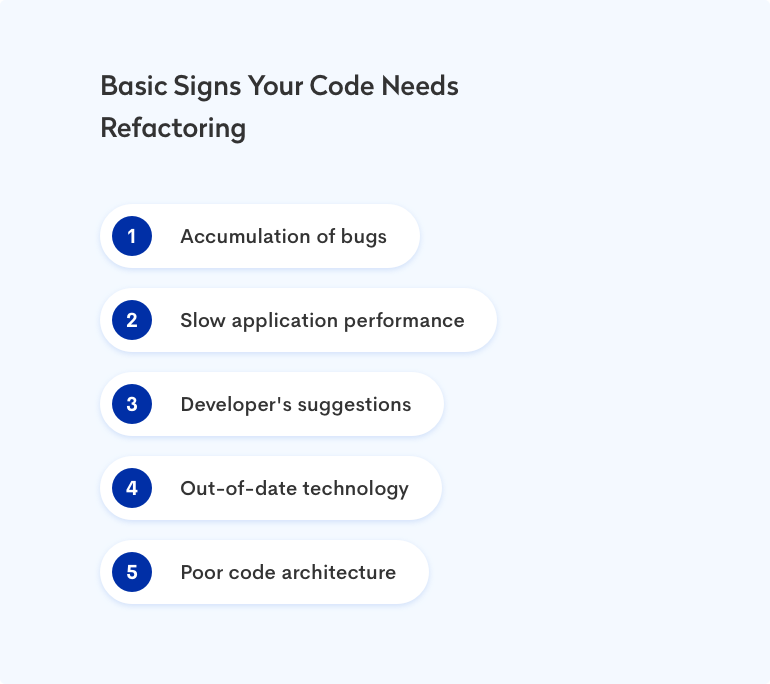Creating a professional web application means not only implementing new features but also testing the system regularly and checking the code’s performance. When the code is prepared in a rush, the quality may suffer. What should you do to ensure your team develops high-quality IT solutions and prepares well-structured code? In most cases, you need to start refactoring code to achieve desirable results.
What signs should you look for to know when your code needs refactoring? Why is refactoring extremely important when it comes to achieving your business goals? We have a great source of information for you to answer these questions. Check out this article to get a knowledge boost and guidance when it comes to refactoring. You will learn the business value of this process and get inspired to develop your product successfully.
What Is Code Refactoring?
Refactoring is the process of improving existing code. It helps to work with the code and makes it easy to read, maintain and ensures that it’s well-structured. Furthermore, cleaning up the code minimizes the chances of bugs and allows you and your team to add new features easily.
What’s the business value behind refactoring? Well, code refactoring is essential if you plan to scale up your application in the future. Let’s look at a common example. As products develop, they often can’t handle the increased user traffic. As a result, your system stops developing. Improving the code will allow you to create a scalable and more flexible solution that can adapt to current technological trends. In other words, you will be able to adjust the application to users’ needs. Keeping your code up to date is also key to avoiding security threats.
Although this process doesn’t bring visible or tangible results, such as new functionalities, it is an important long-term investment for your project’s future. Skipping refactoring can lead to technical debt, and getting out of it can be very time-consuming and expensive. Want to get more info about technical debt? Read the article below:
[sneak-peak id=732011 v=1]Simply put, code refactoring is a way to stop getting into technical debt or remove it.
Why Refactoring Is Important From a Business Perspective: The Main Advantages
As we mentioned earlier, refactoring comes with many important business benefits for later project development stages. Let’s summarize all the advantages of code refactoring:
- Improves code quality and readability
- Prevents bugs
- Key for long-term product development
- Makes it easy to scale applications in the future
- Saves money
- Facilitates developers’ work
- Makes it easy to introduce new functionalities
- Prevents technical debt
- Upgrades system security – although system security should be upgraded regularly, developers often do this work when refactoring all the libraries and updating all the frameworks to newer versions that have longer support or maintenance time. Old code may use libraries that are not maintained anymore.
Well-structured code guarantees system stability, quality, and flexibility. A lack of such code may cause problems at a later stage of the project. Therefore, if you need to refactor your project’s code, don’t wait. The sooner you start this process, the better your results will be.
5 Basic Signs Your Code Needs Refactoring
Visible signs may indicate the need to refactor your application’s code. So how can you know whether your code needs to be refactored? Check out the points below.
1. Developer Communication
In many cases, developers will report the need to refactor code, and it usually means that you can’t procrastinate it any longer. Working with chaotic and unreadable code is not only demotivating for those involved in the process but also a surefire way to negatively impact the project.
2. Bugs
Finding more and more bugs in the application may be a clear sign that your project needs changes. Reoccurring errors and difficulties with effectively scaling your product can lead to more significant problems. Ignoring such signs leads to an accumulation of errors, which contributes to a malfunctioning app.
3. Slow Application
If your application’s performance slows down and it can’t handle heavy user traffic, that’s a clear sign that changes are inevitable. As you develop your product and plan to reach a wider group of users, you also need to optimize the app to meet the current load. Long story short, performance problems, ineffective new-feature implementations, bugs are visible symptoms to monitor.
4. Out-of-date Technology
Using systems based on outdated technologies not only slows down the application but also increases the risk of data leakage. If your project is based on these types of systems, refactoring may be necessary to successfully develop your application in the future.
5. Poor Code Architecture
Unreadable and chaotic architecture is usually the result of a rush to finish the project. Rushing to introduce new functionalities, a lack of regular code reviews, and messy organization often contribute to project problems.
Code Refactoring Is Key to Building High-Quality Products
Maintaining high-quality code is essential if you want to meet users’ expectations and easily implement new functionalities. That is why code refactoring is a long-term investment that will reward you with an efficient product that allows you to achieve your business goals and stay ahead of the competition.
If you notice the need to refactor, start doing it as soon as possible. Delaying this process can increase the number of problems and lengthen the refactoring time.



